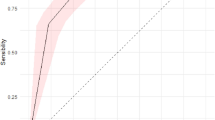Abstract
As a foreign body, the peritoneal dialysis (PD) catheter represents a potential source of infection, particularly for immunosuppressed renal transplant patients. A retrospective study was therefore undertaken to compare the risks and benefits of our policy of removing PD catheters at 3 months following renal transplant, which was established to allow for early re-initiation of dialysis. Between 1984 and 1990, 43 renal transplants were performed in 35 children who had been receiving maintenance PD. During the 1st month post transplantation, the PD catheter was used in 25 patients (58%) because of acute rejection or primary allograft non-function. Thirty-one patients were eventually discharged with functioning allografts and a PD catheter in place. Of them, 43% developed a catheter-related infection within the next 2 months, a period during which PD was not performed. Potential contributing factors included a history of catheter-related infection prior to transplantation, use of high-dose methylprednisolone to treat acute rejection, and the type of maintenance immunosuppression prescribed; conversely, the use of prophylactic antibiotics appeared to decrease this risk. This study established the potential need for the catheter during the first few weeks, but because of the infection risk of 43% by 3 months post transplantation, our protocol was revised to include catheter removal at the time of hospital discharge. From 1990 until the end of 1992, an additional 19 PD recipients underwent transplantation. In this group, catheters were used during the 1st month in 6 children (32%). Fifteen patients were discharged with a functioning allograft and only 1 patient returned to PD at 12 months post transplant. It is concluded that PD catheters represent an additional source of infection following transplantation and should be removed at the time of hospital discharge, after which the likelihood of use is low.
Similar content being viewed by others
References
McEnery PT, Stablein DM, Arbus G, Tejani A (1992) Renal transplantation in children. A report of the North American Pediatric Renal Transplant Cooperative Study. N Engl J Med 326: 1727–1732
Fennell RS, Orak JK, Hudson T, Garin EH, Iravani A, Va Deusen WJ, Howard R, Pfaff WW, Walker RD, Richard GA (1984) Growth in children with various therapies for end stage renal disease. Am J Dis Child 138: 28–31
Kaiser B, Stover J, Polinsky M, Baluarte HJ (1986) The effect of different dialysis modalities on growth in children with chronic renal failure. Kidney Int 29: 233
Evans DH, Sorkin MI, Nolph KD, Whittier FC (1981) Continuous peritoneal dialysis and transplantation. Trans Am Soc Internal Organs 27: 320–323
Patel S, Rosenthal JT, Hakala TR (1983) Management of the peritoneal dialysis catheter after transplantation. Transplantation 36: 589–590
Stefanides CJ, Balfe JW, Arbus GS, Hardy BE, Churchill BM, Rance CP (1983) Renal transplantation in children treated with continuous ambulatory peritoneal dialysis. Perit Dial Bull 3: 5
Steinmuller D, Novick A, Brown W, Vidt D, Nakomata S (1984) Renal transplantation of patients on chronic peritoneal dialysis. Am J Kidney Dis 3: 436–439
Dutton S (1984) Ascites in the CAPD patients post-transplant. Perit Dial Bull [Suppl] 4: 146–149
Tsakiris D, Bromwell SP, Briggs JD, Junor BJR (1985) Transplantation in patients undergoing CAPD. Perit Dial Bull 5: 161–164
Leichter HE, Salusky IB, Ettenger RB, Jordan SC, Hall TL, Marik J, Fine RN (1986) Experience with renal transplantation in children undergoing peritoneal dialysis (CAPD/CCPD). Am J Kidney Dis 8: 181–185
McDonald MW, Sterioff S, Engen DE, Zincke H, Kurtz SB (1987) Renal transplantation in patients with indwelling continuous peritoneal dialysis catheters. J Urol 137: 849–851
Malagon M, Hogg RJ (1987) Renal transplantation after prolonged dwell peritoneal dialysis in children. Kidney Int 31: 981–985
Mochon M, Kaiser B, Dunn S, Palmer J, Polinsky MS, Schulman SL, Flynn JT, Baluarte HJ (1992) Urinary tract infections in children with posterior urethral valves after kidney transplantation. J Urol 148: 1874–1876
Swartz R, Messana J, Starmann B, Weber M, Reynolds J (1991) PreventingStaphylococcus aureus infection during chronic peritoneal dialysis. J Am Soc Nephrol 2: 1085–1091
VanderMeer JWM (1987) Defects in host-defense mechanisms. In: Rubin RH, Young LS (eds) Clinical approach to infection in the compromised host, 2nd edn. Plenum, New York, p 61
Rubin RH (1987) Intection in the renal and liver transplant patient. In: Rubin RH, Young LS (eds) Clinical approach to infection in the compromised host, 2nd edn., Plenum, New York, p 557
Leigh DA (1969) Peritoneal infections in patients on long-term peritoneal dialysis before and after human cadaveric renal transplantation. J Clin Pathol 22: 539–544
Read RR, Eberwein P, Dasgupta MK, Grant SK, Lam K, Nickel JC, Costerton JW (1989) Peritonitis in peritoneal dialysis: bacterial colonization by biofilm spread along the catheter surface. Kidney Int 35: 614–621
The North American Pediatric Renal Transplant Cooperative Study (1994) Annual Report. Clinical Coordinating Center, Brooklyn, New York
Author information
Authors and Affiliations
Rights and permissions
About this article
Cite this article
Palmer, J.A., Kaiser, B.A., Polinsky, M.S. et al. Peritoneal dialysis catheter infections in children after renal transplantation: choosing the time of removal. Pediatr Nephrol 8, 715–718 (1994). https://doi.org/10.1007/BF00869099
Received:
Revised:
Accepted:
Issue Date:
DOI: https://doi.org/10.1007/BF00869099




